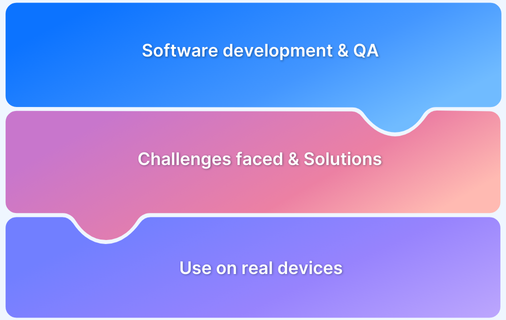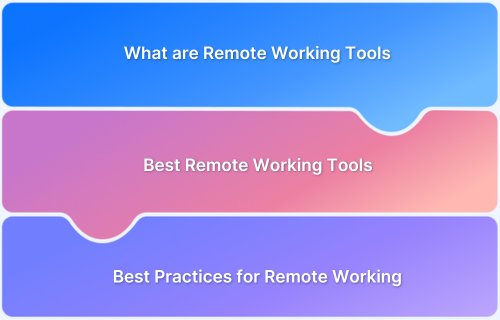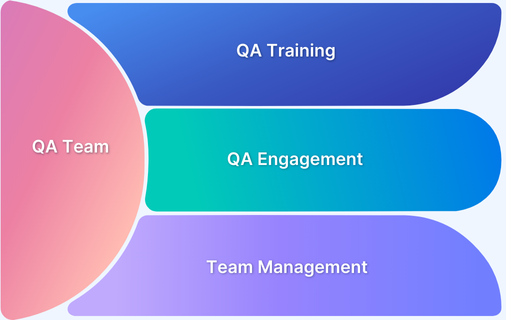Managing a remote QA team effectively is the key to ensuring that the highest standards of software quality are met. It involves regular communication, defining clear test strategies, prioritizing test cases, delegating tasks effectively, and tracking progress.
Overview
Key Roles in a QA Team
- QA Lead: Oversees the testing strategy, coordinates the team, and ensures alignment with project goals.
- Manual Testers: Execute test cases, identify functional issues, and verify software against requirements.
- Automation Engineers: Develop and maintain automated test scripts to improve efficiency and consistency.
Key Aspects of Managing a Remote QA Testing Team
- Setting clear expectations: Clearly define testing goals, quality standards, and a detailed test strategy to keep the team on track.
- Communication and collaboration: Keep the team informed with regular updates, foster cross-functional communication, and implement a clear process for managing defects.
- Task management and prioritization: Create well-structured test cases, focus on high-risk areas, and assign tasks based on each team member’s expertise.
- Performance monitoring and improvement: Track important metrics, provide feedback regularly, and continuously improve processes for more efficient testing.
- Technical skills development: Ensure your team is proficient in relevant tools and continuously upskills on the latest technologies.
This article will provide you with proven tips to manage remote quality assurance (QA) teams and maintain software quality.
Effective Tips for Every Remote QA Testing Team
Here are some of the most effective tips for every remote QA Team to follow:
1. Detailed Communication
Communication is essential for remote QA teams to stay aligned, address issues promptly, and meet project deadlines. Clear communication helps avoid misunderstandings and ensures everyone is on the same page regarding goals and expectations.
Follow these tips to keep your team aligned.
- Regular check-ins: Hold daily or weekly stand-ups to discuss progress, blockers, and upcoming tasks
- Centralized documentation: Use tools like Jira or Confluence for test cases, results, and defect tracking to ensure transparency
- Clear expectations: Make sure everyone understands their responsibilities and timelines to prevent confusion
- Collaborative review sessions: Regularly review test results and defects together as a team to encourage knowledge sharing and alignment
- Encourage feedback loops: Foster an environment where team members can provide feedback on processes and test strategies to drive improvements
2. Focused tracking of progress
In a remote QA setup, tracking a team’s progress – what went wrong, what worked, and the learnings – helps ensure that bugs are not missed, and product quality does not suffer. Managers need to confirm that the team has clear targets for each day, week, and month. These targets can vary from the number of tests run, the number of features tested, the number of bugs detected, and so forth.
Consider implementing a Key Performance Indicator (KPI) system of some kind that assigns a number, label, or color to the performance. For example:
1-3: Exceptional
4-6: Excellent
7-9: Decent
10: Needs Improvement
These numbers can determine team performance as frequently as necessary. Managers can keep track of how their team fares each day and get a handle on any roadblocks or disruptions before they severely affect product quality.
3. Single-source Reporting and Result Evaluation
When working in isolation, it is vital to generate detailed reports on completed tasks for clients so that they do not feel neglected or out of the loop. In addition to the targets described in the previous point, this helps managers stay on top of their team’s progress.
A management tool such as Jira lets managers accomplish several tasks in this vein:
- Remote planning each task
- Separate development tasks from QA tasks
- Evaluate the team’s productivity
- Identify areas requiring improvement or refinement
- Generate reports on errors found, time taken to test, and changes made
4. Using the right tools
Remote work, especially in QA testing, requires the right set of tools to ensure tasks are completed efficiently and without complications.
Testers need access to real browsers, devices, and operating systems, along with automation frameworks to run test cases seamlessly. To achieve this, cloud-based infrastructure is essential for providing the necessary testing environment.
Moreover, collaboration is key for remote teams. Rather than working on isolated test plans, testers must have tools that enable them to come together on a unified test plan, allowing for shared workflows and smoother teamwork.
This collaborative approach ensures that teams can work in sync, track progress collectively, and resolve issues more effectively, leading to faster and more accurate testing cycles.
5. Established bug documentation guidelines
Whether working from home or the office, QA is all about quickly and effectively identifying and documenting bugs. Remote QA requires a heightened focus on establishing clear bug documentation standards. With testers often working in isolation, it’s easy for team norms to be overlooked. To minimize resource-draining issues, testers should adhere to consistent bug reporting practices, such as including detailed descriptions and screenshots.
Automated tests are critical in CI/CD pipelines, triggered with each new build, to maintain quality and efficiency in DevOps processes. Tools like Jira and GitHub streamline bug tracking, reducing time spent troubleshooting and improving collaboration.
6. Establish Clear Communication Channels
Use tools like Slack or Microsoft Teams to create dedicated channels for specific discussions, ensuring team members stay connected and aligned. Prompt communication helps address issues quickly and keeps everyone on the same page.
7. Leverage Cloud-Based Testing Tools
Cloud testing platforms like BrowserStack allow teams to run tests across real devices and browsers, ensuring comprehensive test coverage without needing physical hardware. This is especially useful for remote teams that need flexibility and scalability.
8. Set Up a Centralized Test Repository
A centralized repository for test cases, bug reports, and documentation keeps everything organized and accessible. Tools like BrowserStack Test Management and Jira help streamline access, making it easy for team members to collaborate, review, and update as needed.
9. Use Version Control for Test Scripts
Store test scripts in a version control system like GitHub or GitLab. This practice allows for effective management of changes, tracking of revisions, and ensures team-wide consistency in testing processes.
10. Focus on Comprehensive Documentation
Detailed documentation of test cases, results, and defects ensures that the testing process is structured and transparent. Accessible documentation allows all team members to understand and follow the QA process accurately.
11. Try Behavior-Driven Development (BDD) for Better Collaboration
BDD Framework aligns team members around shared scenarios that define application behavior. Writing test cases in simple, user-focused language helps prevent miscommunication and ensures that everyone—from developers to stakeholders—understands the requirements.
12. Manage Time Zones Effectively
With team members across different time zones, tools like World Time Buddy make scheduling easier. Coordinating meeting times and setting clear deadlines ensures timely communication and feedback, helping to maintain productivity and meet goals on schedule.
Why BrowserStack is ideal for Remote Testing Teams?
BrowserStack is an ideal platform for remote QA teams, offering powerful tools for managing and optimizing testing workflows.
- BrowserStack Enterprise is tailored for remote QA teams, providing unlimited user access and low per-user rates for efficient scaling. It integrates with tools like Jira, Trello, GitHub, and Slack, streamlining team collaboration. With over 3,500 real devices and browsers, it ensures extensive test coverage without emulators. Additional features like real-time debugging, geolocation, and real-user conditions support accurate, real-world testing. BrowserStack Live for Teams enables effective collaboration, thorough testing, and sustained productivity in remote settings.
- BrowserStack’s Test Management, make all test cases, bug reports, and documentation centralized in a single location. This setup allows QA teams to stay organized and easily access project documentation, making it easier to coordinate and execute testing plans while tracking progress effectively.
- Test Observability offers real-time insights into test performance, helping remote teams quickly identify and resolve issues. The feature also provides detailed reports and data to aid in troubleshooting and maintaining continuous integration and delivery (CI/CD) pipelines, ensuring an uninterrupted workflow.
Conclusion
In conclusion, remote QA teams can thrive by prioritizing clear communication, effective progress tracking, and a unified reporting structure. Implementing detailed bug documentation and adopting Behavior-Driven Development (BDD) further enhances collaboration and efficiency.
BrowserStack is an excellent tool for remote testing teams, offering centralized reporting, real-time collaboration, and robust test management. Its scalability and observability streamline workflows, ensuring quick issue detection and resolution.
By combining these best practices with BrowserStack’s powerful tools, teams can achieve greater productivity, faster releases, and improved software quality.







